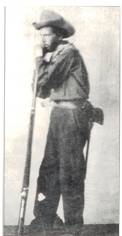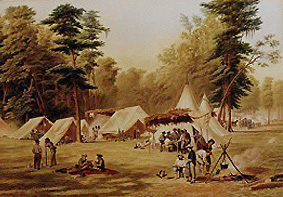Today, I had a wonderful day doing webcasts (more accurately, distance learning & teleconference) with Region XI Library and Media Services. The staff there is so sharp and helpful. The more I work with this group, the more impressed I am with them. The weather here has changed. Yesterday was so nice. Today it turned cold, and according to the news/weather, severe weather is in the works for tomorrow, when I am scheduled to be at the Texas Civil War Museum. This afternoon, I did manage to squeeze in a visit to the Kimball Art Museum (Biblical Art) and Amon-Carter Museum (Russell-Remington). Of course, these fine museums also had many other works displayed. My head is still spinning from sensory overload. I wish North Louisiana had culture like this.
One of the most interesting finds I made was of some work by a Confederate soldier who was an artist, Conrad Wise Chapman. A portrait of the artist and one of his paintings is below. I found a great site, http://www.cottage-industries.com/Merchant/default5.htm that says this about him: “Conrad Wise Chapman was born in Washington, D.C., in 1842, second son of the artist John Gadsby Chapman. The elder Chapman was already well respected, especially for his oil on canvas The Baptism of Pocahontas, placed in 1840 in the United States Capitol rotunda. In 1848 the family moved to Europe taking up residence in Rome. While in Europe, John Chapman taught both his sons, Conrad and John Linton, to paint. When news of the Civil War reached Rome, Conrad rushed to join the Confederacy.
Unable to get to Virginia, Chapman enlisted in the Orphan Brigade, 3rd Kentucky Company D; Paducah Company. During the battle of Shiloh, Chapman suffered a serious head injury. After the battle, Confederate forces retreated to Corinth, Mississippi, the site of his painting, ~ Confederate Camp, 3rd Kentucky Infantry at Corinth Mississippi. Chapman painted the scene on May 10, 1862 only days after the Battle of Shiloh. The Lonesome Sentry is in the bottom left hand corner and an enlargement of the canvas is featured below. This is a self-portrait of the artist. The older soldier in bare feet seated at the cooking fire and plucking a chicken is said to be a portrait of the artist’s father. This painting became the basis for the well-known color lithograph of 1871 by M&N Hanhart of London. While on furlough in 1863, a photograph was taken of Chapman in his uniform assuming the pose of The Lonesome Sentry. Chapman’s painting is the masterpiece of the war. No other image depicts life in a Confederate Camp as well as this. Note the barefooted private soldiers in contrast to their Negro slaves or the Confederate officers in full uniform in the far background. A large collection of Chapman’s painting is on display at the Museum of the Confederacy and the Valentine in Richmond, Virginia. Other famous paintings by Conrad Wise Chapman include the paintings of The Hunley, The David, Evening Gun (Ft. Sumter), The Bombardment of Ft. Moultrie, White Point Battery, and the Confederate ironclads scene in Charleston Bay and City.”


